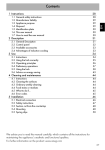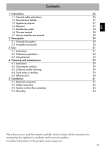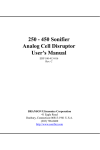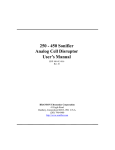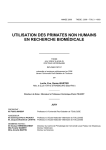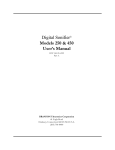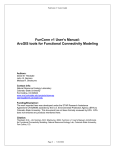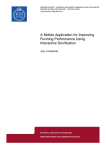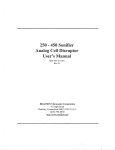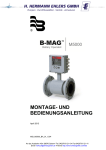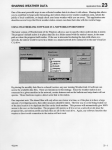Download Safety Guidelines and Operating Instructions for Working with
Transcript
The University of Heidelberg or the chancellor as a representative directs hereby the following measures for handling microorganisms of containment level III (according to DIN 58956). The safety guidelines and instructions for laboratory work are a predetermined minimum framework. The project supervisor, in consultation with the Committee on Biological Safety, must adapt or extend these regulations to local and work-specific conditions. That implies that the project supervisor must add organismspecific items to the operating instructions or specify them. This can be achieved by the creation of own instructions. (e. g. disinfection and organizational measures). The own instructions strongly depend on the handled organisms. The disinfectants used in the laboratories must be included in the list of disinfectants, which are certified by the Federal Health Office (Bundesgesundheitsamt). The project supervisor determines what kind of cleaning agents/methods and disinfectants will be used. The concentrations and exposure times indicated by the manufacturer must be listed in the operating instructions. Within the laboratory rooms the operating instructions must be accessible for everyone. Each employee is expected to confirm the information before starting work. An oral workplace-specific instruction must be performed based on these operating instructions. The operating instructions are intended to provide complementary information to pre-existing instructions from other fields of occupational safety and cannot replace them. Safety Guidelines and Operating Instructions for Working with Microorganisms of Biosafety Level III Containment level III is relating to laboratory work in genetic engineering which, according to the current state of scientific knowledge, constitutes a high individual's and a low general risk; DIN 58956 part 1 The University of Heidelberg or the Chancellor of the University as a representative considers hereby the following measures to be necessary according to DIN 58959 part 3 for laboratory working with microorganisms of Biosafety level III. This includes the implementation of the measures indicated below. These operating instructions are intended to provide complementary information to preexisting instructions from other fields of occupational safety and cannot replace them. 1. HAZARD IDENTIFICATION, APPROVALS Prior to starting work the project supervisor has to identify the potential risk of the microorganisms that are used and if necessary, after consulting the authorized agent for biological safety, submit an application to the relevant authorities. Genetic engineering work involving microorganisms. which are part of §1 of the Regulation on Working with Animal Pathogenic Organisms, must be authorized by the Regional Council of Karlsruhe – Department 37 before starting work. For working with microorganisms, which are part of § 44 German Protection against Infection Act, permission from the Regional Council of Karlsruhe – Department 25 must be obtained. Genetic engineering work involving microorganisms of containment level III must be additionally registered as further work in the genetic engineering facility. For further questions regarding the above points please contact the authorized agent for biological safety, University of Heidelberg. Starting genetic engineering work involving microorganisms of containment level III is possible only after approval by the Committee for Biosafety, University of Heidelberg. To this end, submit a request to the chairman of the committee. The committee together with the project supervisor will discuss the techniques to be applied and specifies the necessary safety measures, which are listed under item 11 of this instruction. The project manager is assigned a laboratory space for a requested period, an extension is available on additional application. 2. These operating instructions apply to Rooms F02.458, F02.459, F02.460, F02.462, F02.463, F02.464, F02.466, F02.467, F02.468 und F02.469, building INF 410, University of Heidelberg. 3. NAMES AND PHONE NUMBERS Project supervisor: ABS: Head of Laboratory: Safety engineer: In-house medical service: Prof. Dr. Bartenschlager Prof. Dr. Zeier/ Prof. Dr. Heeg Prof. Dr. Fackler Prof. Dr. Kräusslich Dr. Siller Dr. Kehm Herr Biedermann (Labor F02.469) 564569 (Labor F02.468) 35-297-0/568310 (Labor F02.467) 561322 (Labor F02.466) 565002 542340 5632372, 548541 542033 568960 Emergency Technical Assistance Service 56 5111 4. The security area for the handling of organisms of containment level III must be marked with the warning sign "biohazard” 5. ACCESS CONTROL 5.1 Access to and work in the laboratory is only permitted to personnel authorized by the project supervisor. Personnel have to be registered in a log book. If laboratory space is required the applicant has to specify the names of persons authorized to such access. Personnel performing genetic engineering procedures must be qualified and adequately instructed by the project supervisor and by the head of laboratory. Personnel must be lectured on possible hazards of the respective work place on an annual basis and in case of relevant safety changes of work methods. The project supervisor has to instruct the personnel on the special dangers for expectant and nursing mothers. Participation in such instruction sessions is mandatory and requires written confirmation. 5.2 In exceptional cases unauthorized personnel are permitted to enter the facility only after consultation with the project supervisor and the head of laboratory. Entering the safety area would have to be an approved exemption (e. g. to do repair work) and will only be permitted after surface decontamination, decontamination of the equipment to be repaired or serviced and after complete removal or sealing of all organisms with risk potential. Written permission for guests to enter the laboratory must be obtained from the head of laboratory or an authorized representative. Visitors and maintenance personnel who enter the BSL 3 laboratory must be fully informed of the potential risks, required practices and procedures that they must follow. All visitors must complete and sign the Biosafety Level 3 Visitor Clearance Form prior to entry of the BSL3 facility. Visitors must be accompanied by the head of laboratory, the facility manager or an authorized BSL3 researcher for the duration of their visit to the facility. Maintenance and repair work must be documented in the occupancy list, must be announced to the laboratory users and will be recorded in the log book. Both the work carried out and the persons involved must be recorded. 5.3 The safety area will be closed twice a year for maintenance work and disinfection. A medical check-up through the facility doctor is required and personnel performing regular maintenance work and personnel with access authorization must be adequately instructed as to safety regulations. 5.4 The project supervisor has to arrange a medical check-up for all personnel performing regular work in the safety area before starting work and afterwards on an annual basis (if the duration of employment is below 12 month, a final medical examination may be omitted). These examinations must be performed by a facility doctor in accordance with the principles of the employers' liability insurance association G42 and G43. The facility doctor of the University of Heidelberg, Dr. Marion Predikant, has such authorization. Before starting an activity and afterwards the facility doctor stores serum samples. If it is possible, immunization against the organisms of relevance with hazard potential should be carried out. 5.5 Personnel with access authorization have to inform the project supervisor or the facility doctor about their pregnancies as early as possible and without being asked to. Further, they must report on any affected immune defence (e. g. radiotherapy, treatment with immunosuppressive drugs, cytostatic agents, systemic treatment with antibiotics or cortisone, serious infectious diseases, skin diseases with impaired protective function or decontamination properties of the skin, severe diabetes mellitus). Pregnant women are not permitted to work with human pathogens. 6. CONTROL; PROTCOL 6.1 Control The safety area is constantly monitored by video surveillance. The monitors are located in buildings INF 345 (room 001 and room 166), INF 346 (room 102) and INF 324 (room 459). During normal working hours the laboratory manager in building INF 346 is permanent available by phone. In order to enable a rapid contact, telephones are installed in rooms F02.466 - F02.469. Working alone, without the possibility to contact a person who is available on the campus, is not permitted. Work outside regular working hours will be possible only in exceptional cases and shall be subject to prior approval by the head of laboratory. In these cases, a second person staying on the campus must also be available by phone. In case of an emergency this person is then capable to organize help. 6.2 Work centre occupancy list Planned work should be registered at least one day in advance and wherever possible coordinated with the users of the other laboratory rooms (due to the necessary control) 6.3 Laboratory log book There is a laboratory log book (daily record) deposited in the airlock. Persons are required to record each entry to the laboratories, including names of persons entering the laboratory, date, time of entry and exit and an indication of the work done and any special incident (accidents, unexpected outcome of an experiment, etc.). Experimental work must be recorded in a comprehensible way with indicating the organisms used and their quantity. To simplify the daily logging detailed information about persons, projects, agents and experimental techniques and disinfection procedures will be recorded in individual lists / descriptions in a separate appendix of the log book. These lists must be updated continuously. The detailed individual scientific record must not replace the entries in the laboratory protocol book. Repair and maintenance work as well as entries to the safety area by non-authorized persons (5.2 and 5.3) are to be recorded as well. 6.4 Scientific protocols Laboratory log books may not be removed from the safety area. If details of the scientific protocol are needed outside the L3-area, relevant entries may be sent by fax from the laboratory. For this purpose a fax machine for common use is located in room F02.463. 7. CODE OF CONDUCT; LABORATORY PRACTICES Prior to starting work in the laboratory the experimentalist will have to check whether all conditions set for the regulated operations in the safety area are met. These include adequate disinfectant, laboratory coats, gloves, empty containers and plastic bags for autoclaving and the control of the pressure status within the safety area and the proper locking of the exterior doors. Also practical aspects of laboratory work such as availability of sufficient quantities of expendable items should be considered in advance. 7.1 Air lock and pressure status The safety area is separated from the environment through an air lock. Compared to the environment there is a low pressure in the safety area (circa 30 Pa). The facility is equipped with a digital room pressure monitor that has both an audible and visual alarm. In the laboratories a green signal displays the correct low pressure. Audible alarms are activated in the laboratories and in the corridor if the pressure drops to a prescribed limit value (less than 20 Pa). Simultaneously switching to a red signal occurs in the laboratories and in the corridor. The central control room must be informed immediately about the cause of the alarm. Access to the lock room is only possible for authorized personnel possessing an activated (licensed) access card. In order to prevent unauthorized access to the safety area the loss of the access card must be reported immediately to the head of laboratory. In the air lock there is a reduced pressure relative to the corridor but an overpressure relative to the laboratories. After one of the air lock doors has been closed it takes approximately 1 minute until the pressure returns to normal in the air lock. Only then a second door may be opened. The air lock doors are alternately locked. In case of emergency the locking can be deactivated by means of an alarm button in the air lock and the corridor of the safety area, respectively. So, escape is possible even if a second door is open. Due to the alternately locking of the air lock doors it is important to ensure that both air lock doors are completely closed during laboratory work. 7.2 Personal protection, protective clothing Lab Coats Mandatory Eye protection Mandatory Gloves Mandatory Put on protective clothing in the airlock for working in the safety area. Wear a closed laboratory coat (disposable coat), wear non slippery shoes closed on all sides (exclusively used for the safety area) with plastic overshoes, nitril gloves and goggles with side protection and an upper protection for the eyes. It is strongly recommended to wear a surgical face mask in the laboratory rooms. When working with aerosol transmitting organisms (e. g. Mycobacterium tuberculosum) a respirator mask, filtering airborne particles must be worn. Hair must be covered with a surgical hood; long hair should be tied back and secured. When working with infectious material 2 pairs of nitril gloves must be worn; when necessary, the outer pair is replaced. Before use of general equipment, e. g. phone, refrigerator, laboratory door etc. the outer pair of gloves must be replaced or disinfected. This must also happen if the experimenter touches other objects after working at the safety work bench. Disposable gloves must be removed by turning them inside out and may not be reused. Before leaving the safety area persons must dispose of laboratory coats, plastic overshoes, gloves, surgical hood and the surgical face mask or respirator mask and must leave them in the collecting box in the airlock. The next day the first user of the autoclave will dispose of the container for autoclaving. The shoes must be sprayed with Incidin Liquid Spray and are to be kept in the air-lock. Before leaving the safety area persons must disinfect their hands twice and then wash them if necessary. The air-lock offers an elbow operated sink and a soap, disinfectant and a towel dispenser. 7.3 Safety measures Eating and Drinking prohibited Smoking prohibited During the first instruction each user of the laboratory will be informed about the location and function of disinfectants, fire extinguishers, first aid facilities, eye showers, emergency showers as well as about the escape plan. The doors of the laboratory rooms must be closed. After finishing work, all surface areas must be disinfected (see hygiene plan). In working areas it is not permitted to eat, to drink, to snuff, to chew gum, to smoke or to use make-up. Food and tobacco products may not be brought into the laboratory or kept there. Watches and rings with gemstones or rough structures, which can rupture the gloves, may not be worn. When pipetting it is always necessary to use mechanical pipetting devices. Pipetting without mechanical pipetting devices is strictly prohibited. In the safety area it is not permitted to use laboratory equipment, which may constitute a risk of injury (glass, needles, scalpels). Justified exceptional cases allow the use of such objects after the approval by the ABS. The exceptions and the necessary safety measures will be recorded in the log book under the heading “project description”. Refrigerators and freezers, in which infectious material is stored, are to be marked with the warning label “Biohazard”. Laboratory rooms, working place and all the community equipment have to be kept in an orderly state. On the laboratory benches only the actually required equipment and materials should be available. Inventories are to be stored in the lockers provided for this purpose. When work is finished all organisms must be stored as required or disposed of in an adequate way according to current scientific experience (see disposal). The correct execution of the laboratory work should be monitored. If essential for the evaluation of the risk potential, the identity of the used organisms needs to be verified at regular intervals. 7.4 Work involving development of aerosols When dealing with organisms with hazard potential where aerosols can develop (e. g. pipetting, transferring and mixing of liquids, opening of vessels, which have a vacuum or excess pressure, crushing of organic tissue) it has to be insured that the aerosols cannot reach the working area. Two measures are suitable for this purpose: a) Carrying out experimental work at a safety work bench class II according to DIN 12950. Work instructions for using the safety work bench are generated (see 14.). These include the operation planning, individual work steps and the disinfection of the surfaces. Furthermore attention is drawn to flaws in handling the safety work bench, which can affect the safety functions (e. g. covering of the air slots, turbulence formation by the introduction of equipment or heat expansion, damage of the particulate air filters). b) Use of equipment where no aerosols are released: Use of sonifiers with tumblers applicable to sonifying in closed vessels or use of sonifiers inside a safety work bench. All centrifuges are equipped with tight-closing rotors. The rotors are loaded and closed inside the safety work bench. Tight-closing safety tumblers and corresponding tubes are required (see 15). The handling of rotors, which are not authorized by the ABS, is prohibited in the safety area. The shaking incubator (Infors: Aerotron) may be used only with attached cover. Before removing the cover the shaking platform must have been stopped for at least 5 minutes to ensure that aerosols can deposit. After finishing work the incubator must be disinfected with Incidin Liquid Spray Working equipment that had direct contact with organisms of potential hazards must be autoclaved or disinfected on their surfaces prior to a cleaning (disinfection of the surfaces after use can be achieved by means of Incidin Liquid Spray). This also includes all equipment that was used inside a safety work bench. Equipment and materials which are to be removed from the laboratory, but where the possibility of a contamination with organisms cannot be excluded, must be disinfected in the laboratory, or if possible be autoclaved in advance. 8. HYGIENE, TRANSPORT AND DISPOSAL 8.1 The main points of this operating instruction concerning hygiene and disinfection are summarized in the hygiene plan, which is visibly placed in each laboratory room and in the air-lock. 8.2 Infectious material has to be transported to the safety area and between the rooms inside the safety area in closed, break- and leak-proof containers only, which must not be contaminated on the outside. This also concerns the transport of contaminated waste to the autoclave. In case of a contamination on the exterior of a container, disinfection of the surface can be achieved by means of Incidin Liquid Spray. Break- and leak-proof sample vessels of translucent form-stable plastic material with a comprehensive screw-on lid, which is strengthened by fabric tape, must be used for shipment of infectious material. The sample vessel must be placed in a protective container and packed with sufficient absorbent material. The protective container shall meet the same requirements as the sample vessel. The outer packaging depends on the transported material and the means of transport. For sending samples by a shipping agency (road transport) please contact Mr. Scheid (division: Hazardous goods advice, Tel. 548542). For sending samples by air freight please contact Dr. Kehm (Tel.: 5632372 or 548541). 8.3 Samples have to be stored inside the facility. Containers for storage must be adequate to storage conditions (e. g. storage at -70°C: low-temperatureresistant, unbreakable packaging, which in case of thawing is leak-proof). Furthermore samples must be marked accurately, safely and clearly with label, date and name. For frozen storage a freezer compartment in room F02.463 is available for each research group. A list of the stored samples must be attached to the outside of the freezer. Every six months the project supervisor has to check the stock of samples and to hand in an exact stock list to the head of laboratory. 8.4 For material, which shall be removed for further processing outside the laboratory without prior autoclaving, the project supervisor - in cooperation with the ABS - has to specify individual inactivation steps. 8.5 Before removal from the safety area any kind of waste and autoclavable used equipment must be sterilized in the path-through autoclave (see 13). Waste may only be transported to the autoclave in closed stainless steel boxes and on charging trolleys. If a steel box was possibility contaminated during the loading on the outer surface, disinfection with Incidin Liquid Spray must be carried out immediately. The collection of waste and short-time storage in the laboratory area is already made in stainless steel boxes. After sterilization, the waste is biologically safe and can be disposed of in accordance with the waste directives. Alternatively, the waste can be burnt in the waste incineration plant of the University of Heidelberg. Appropriate collection containers are available for the transport of infectious waste intended for incineration. These disposable containers cannot be opened again without damage. Once the container has been loaded it must be tightly closed and will be co-incinerated. Please do not try to open the containers for infectious material for a second time, rather use as a reusable container. Disposal program: Combustible plastic and paper waste will be collected in autoclavable, unsealed bags, short-time stored in stainless steel boxes and autoclaved in the paththrough autoclave located in room F02.458. Sharp-edged or pointed disposable articles of glass or metal, which are – in exceptional cases – authorized by the ABS, will be collected in special boxes, which must be secured to prevent perforation and adequately labelled. Needles and scalpels will not be disposed separately but in combination with the syringe or the scalpel holder. Protective caps will not be replaced. The filled box will be autoclaved and disposed of afterwards or supplied for combustion. Liquid waste will be collected in sealable and autoclavable plastic containers (volume not exceeding 2 litres). When autoclaving, the containers containing liquids may not be completely closed (explosion hazard). The temperature sensor of the autoclave is to be positioned in a reference vessel which has the same volume as the largest collecting tank to be inactivated. Special waste: In order to prevent risk to personnel health caused by vapours, phenol, formaldehyde or other organic solvents may not be autoclaved. If these chemicals have not themselves a sufficient disinfectant effect (note the concentration), formaldehyde is added to a final concentration of 4%. After disinfection special waste must be disposed of in accordance with the waste directives as hazardous waste. If you need further information please contact the authorized agent for biological safety. Before application of the standard procedure for autoclaving, the operating instructions for handling the autoclave (see item 13) should be observed. The user manual is visibly placed next to the autoclave. 8.6 Liquid waste of the sink An elbow operated sink is available in the air-lock. The sole objective of this sink is hand cleaning and disinfection. It is strictly prohibited to dispose of infectious liquids, cell culture waste or other “non-harmful” waste, e. g. melt water of ice baths, via this sink. Hands must be disinfected before cleaning 9. INCIDENT AND EMERGENCY KEEP CALM AND ACT QUICKLY IN A CONSIDERED AND COORDINATED MANNER! 9.1 General provisions Accidents in the laboratory (injuries or contamination) must be immediately reported to the head of laboratory or his representative. In case of an accident please follow the emergency instructions, which are visibly placed in the airlock. As soon as possible after the first measures the project supervisor must to be informed (see 2.) The project supervisor, for his part, will inform the facility doctor, the authorized agent for biological safety, the safety expert, the ambulance and rescue service and other responsible persons about the accident and the biological agents used. All incidents must be recorded in the logbook. During first aid measures, injuries caused in the laboratory must be disinfected and treated immediately (see below) and be reported to the persons referred to above. When necessary, an ambulance must be ordered and a doctor on call or the facility doctor should be involved. Doctors and ambulance personnel must be informed about the organisms used, so that they can get all information about possible risk of infection. 9.2 Emergencies In case of emergencies the head of laboratory must be notified immediately. He will inform the central control room (ZLT) immediately, Tel. 567272. From here, further operational forces will be contacted. When reporting an emergency, please indicate: Where is the emergency, What happened What kind of help is needed Who is reporting the emergency If confronted with continuing risks, e. g. fire, please exit the security area through the emergency exit windows or - after unlocking – through the air lock. Close all doors after leaving. Operational forces must be informed about possible risks and special protection measures by an authorized person before entering the building. In case of fire In case of fire the appropriate measures referred to the general safety regulations must be followed. Initial fires can be extinguished by the user himself. Foam extinguishers are available in the corridor of the safety area and in the air lock. Meeting place in case of fire Persons, who have to leave the biosafety area unplanned due to fire or other emergency, can dispose of their protective clothing in room F02.508. Furthermore, disinfectants for hand and surface disinfection are provided. Personal security takes precedence over object protection: In case of an uncontrollable fire, please exit the security area as described above. 9.3 Decontamination of persons As far as possible, contaminated persons should remain at the place of accident to prevent any spread of contamination. Contaminated skin is disinfected thoroughly with disinfectants listed in the hygiene plan. Contaminated eyes are rinsed immediately with water with an opened eyelid (eye shower). After that a medical expert must be contacted. Contaminated mucous membranes must also be treated with “Oktinisept” and afterwards a medical expert should be consulted. In the case of large-scale contamination of people, first the affected clothes should be removed and then the skin must be disinfected extensively with disinfectants listed in the hygiene plan. The contaminated clothing is collected in a stainless steel box and is then sterilized. Minor skin lesions are disinfected thoroughly with the disinfectants listed in the hygiene plan. Where appropriate, the blood flow should not be interrupted. Large skin lesions must be treated with wound disinfectants. In case of serious injuries conventional accident assistance may have priority over disinfection. In the event of inhalation, ingestion or swallowing of hazardous organisms, persons affected must be examined by the facility doctor in any case immediately after implementing first aid measures. The facility doctor should be informed about the potential risk based on the index of organisms. 9.4 Contamination of the laboratory Decontamination requires a high level of caution and care. Before decontamination it is important to wear a respirator mask filtering airborne particles (P3S). This is located above the sink in the air lock. In the event of larger contamination and accidents involving the release or spillage of airborne pathogens, the head of laboratory must be called for help. The supporter from the outside places the available rescue hood with forced ventilation combined with a P3 filter in the air-lock. First cover spilled liquids with paper towels or pulp, wet the cover with Incidin Liquid Spray, then soak up the liquid by wiping with a further cloth in a central direction and subsequently spray the surface with disinfectant and allow it to act for 4 hours. The paper towels are collected in a stainless steel box and autoclaved. Slightly contaminated surfaces are sprayed and wiped (gross dirt) with disinfectants listed in the hygiene plan. After spraying again and appropriate exposure, the surface is wiped off once more. Entering of a contaminated area is prohibited to persons who are not directly involved in the decontamination. Access is possible again after release by the head of laboratory or the project supervisor. If necessary, a room may be disinfected using formaldehyde evaporation in cooperation with the certified disinfector of the hospital. 9.5 Incidents in technical facilities Compared to the environment there is a vacuum in the security area. Acoustic alarms are activated in the security area and in the central control room, if the system is defective. In case of alarms an authorized person, who determines further proceedings, must be informed immediately. In case of supply / exhaust air malfunction, work in the laboratory must be stopped immediately, biological material must be secured and locked away. Power failures cause the system change into a safety state, since all flaps are dead closed. In this case also, all activities must be stopped immediately and an authorized person must be informed. In case of malfunctioning equipment within the security area, the head of laboratory who arranges repair works must be informed immediately. If safetyrelevant equipment is affected, e. g. the safety workbench, work must be stopped immediately and biological material must be secured and locked away. 10. BASICS OF LAWS AND REGULATIONS CONCERNING THE SAFETY MEASURES Gesetz zur Verhütung und Bekämpfung übertragbarer Krankheiten beim Menschen vom 18.12.1979 (Bundesseuchengesetz) i.d.F. Vom 27.07.1985 Verordnung über gefährliche Stoffe (Gefahrenverordnung/GefStoffV) I.V.m. Den technischen Regeln Gefahrstoffe “Umgang mit Gefahrstoffen im Hochschulbereich” (TRGS 451) und “Begasungen mit formaldehyd” (TRGS 522) Mutterschutzgesetz vom 18.04.1968 Unfallverhütungsvorschriften (Allgemeine Vorschriften GUV 0.1, Gesundheitsdienst GUV 8.1, Arbeitsmedizinische vorsorge GUV 0.6, Erste Hilfe GUV 0.3 und Biotechnologie VBG 102) Richtlinien für Laboratorien 16.17 Berufsgenossenschaftliche Merkblätter (Merkblätter sichere Biotechnologie B 002 bis B 009) Bekannmachung der vom Bundesgesundheitsamt geprüften und anerkannten Desinfektionsmittel und -verfahren DIN-Taschenbuch 222: Medizinische Mikrobiologie (mit den DIN-Normen 58956 “medizinisch-mikrobiologische Laboratorien”, 58957 “sicherheitstechnische Anforderungen an mykobakteriologische Untersuchungen”, 55515 “Versandverpackungen für medizinisches und biologisches Untersuchungsgut” und 12950 “Sicherheitswerkbänke”) DIN-Taschenbuch 169: Medizin 3 (mit den DIN-Normen 58946 “DampfSterilisation” und 58949 “Desinfektion” By contacting the project supervisor, the head of laboratory or the authorized agent for biological safety you may have access to the above legal provisions. Additional literature: K.H. Wallhäuser: “ Praxis der Sterilisation, Desinfektion, Konservierung”, 5. Auflage 1995; Thieme-Verlag, Stuttgart C.H. Collins: “Laboratory-acquired infections”, 3. auflage 1993; Butterworth-Heinemann Ltd., Oxford S.R. Rayburn: “the foundations of laboratory safety, a guide for the biomedical laboratory”, 1990; Springer-Verlag, New York S. Andelmann, H. Schulze-Halberg (Hrsg.): “Arbeitsschutz in Biotechnologie und Genetik”, 1996; Springer-Verlag, Berlinww 084 Appendix: Authorisations referred to paragraph § 19 German Infektions-Schutzgesetz Organisms: Hanta Viruses Projektleiter: Prof. Dr. M. Zeier Organisms: Human Immunodeficiency Virus, HIV Project leader: Prof. Dr. H.G. Kräusslich within a general permit Organisms: Hepatitis C Virus Project leader: Prof. Dr. R. Bartenschlager Organisms: Dengue Virus Project leader: Prof. Dr. R. Bartenschlager Organisms: Murine Leukemia Virus Project leader: Prof. Dr. O. Keppler (includes a lentiviral nef gen) Organisms: Diagnostics Organisms: General Permission to Project leader: Dr. R. Kehm handle viruses of Biosafety Level II and III referred to § 44 German Infektionsschutzgesetz Project leader: Prof. Dr. K. Heeg Storage of other pathogens: BSE agent, non-pathogenic Bacillus anthracis, Histoplasma capsulatum (reserve sample), TBE (tick-borne meningoencephalitis) isolates














